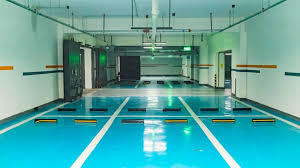Epoxy garage flooring has recently become popular among homeowners, transforming ordinary spaces into functional and stylish areas. This flooring option enhances a garage’s aesthetic appeal and significantly improves its functionality. Originating in industrial settings, epoxy is now embraced in home environments for its durability and stunning finish. Those exploring garage floor coating companies can discover options tailored to residential needs.
Two key factors contribute to its appeal: aesthetics and resilience. Epoxy flooring creates a seamless, glossy, visually striking finish while being extremely robust. The integration of epoxy into home design is a growing trend, mainly due to its practical advantages over other flooring types.
Why Choose Epoxy for Your Garage
Regarding garage flooring, homeowners have various material choices, from bare concrete to tiles and mats. However, epoxy stands out for several reasons. It offers a polished, continuous surface that enhances the existing space without excessive maintenance. Drawing from resources, it becomes clear that epoxy is a favored option due to its aesthetic versatility and unparalleled durability.
Epoxy’s moisture resistance makes it ideal for garages, especially in regions with variable humidity and temperature. Besides, it prevents floor staining from oil, grease, and other automotive fluids, issues commonly encountered with traditional concrete surfaces. Cost-wise, while it may seem like a significant initial investment, epoxy is economical in the long term as it preserves the garage floor, reducing the need for repairs or replacements.
Key Benefits of Epoxy Flooring
Epoxy flooring is lauded not only for its visual beauty but also for its practical benefits that address everyday challenges. Because of its exceptional resilience to deterioration, it’s perfect for spaces subject to heavy foot traffic and vehicle movement. The robust nature of epoxy ensures it withstands the pressure of heavy loads, including cars, storage boxes, and mechanical equipment, without cracking or chipping.
In addition to durability, epoxy is a top choice for its seamless surface that reduces dust and facilitates easier cleaning. Unlike porous concrete, epoxy flooring prevents grime and bacteria from seeping in, promoting a healthier environment. Moreover, its eco-friendly nature aligns with modern sustainability goals, minimizing the need for harsh cleaning agents and frequent replacements.
Best Practices for Installation
Installing epoxy garage flooring involves several stages, making it crucial to follow a well-structured approach for the best results. A detailed preparation of the concrete base is the foundation of a successful application. Any cracks or imperfections should be meticulously repaired, and the surface must be free from dust, grease, and moisture.
The application process usually begins with a primer, which ensures the epoxy adheres correctly. It is followed by carefully mixing the epoxy components. The application should be even, using a roller or brush in small sections for consistency. The surface must cure for at least 24-48 hours, during which it should be kept clean and undisturbed. Hiring professionals guarantees precision and efficiency, and an understanding of garage floor coating companies can provide valuable insights and options tailored to specific needs.
Maintenance Tips for Long-lasting Floors
Proper maintenance of epoxy flooring ensures its vibrant finish and functionality are preserved over the years. Daily care involves simple tasks like sweeping away debris and occasional damp mopping to maintain shine. Regular pH-balanced cleaners that don’t compromise the epoxy’s finish are recommended.
- Acidic cleaners can gradually dull the surface, so stay away from them.
- During winter, remove snow and rock salt promptly to prevent long-term damage.
- Installing protective mats at entry points can catch most of the grit before it scratches the floor.
- Regular checks for any signs of wear allow for timely touch-ups, ensuring the flooring remains immaculate.
Common FAQs About Epoxy Garage Flooring
As epoxy gains traction among homeowners, specific questions frequently arise. By addressing these, users can make informed decisions and enjoy maximum benefits:
- Can epoxy support heavy vehicles? – It is engineered to handle substantial weight, such as cars and motorcycles, without failing.
- Is epoxy slippery? – Textured additives can be mixed into the epoxy to create slip-resistant surfaces, making it safe for wet and dry conditions.
- Does sunlight affect epoxy floors? – Modern formulas contain UV protection, preventing fading and discoloration from extensive sunlight exposure.
Innovative Design Ideas
Besides functionality, epoxy brings creativity to garage floors with its vast design possibilities. Homeowners can choose from many colors and patterns to make their garage a reflection of their style. Whether opting for metallic flakes, solid colors, or high-gloss finishes, epoxy transforms an otherwise mundane space into an area that complements the overall home décor.
Creative patterns such as tiles, geometric shapes, or company logos can be incorporated. The ability to personalize this space ensures it aligns with aesthetic preferences, making the garage not just a storage space but an extension of the home.
Conclusion: Epoxy Flooring for the Modern Home
In summary, epoxy garage flooring blends beauty and resilience, offering a practical, long-lasting solution for modern homes. Its growing popularity is attributed to its transformative effect on garages, taking them from simple storage areas to sophisticated, functional spaces. As homeowners continue to embrace quality and aesthetic diversity, epoxy flooring stands out as a compelling choice, marking a new era in home design.









